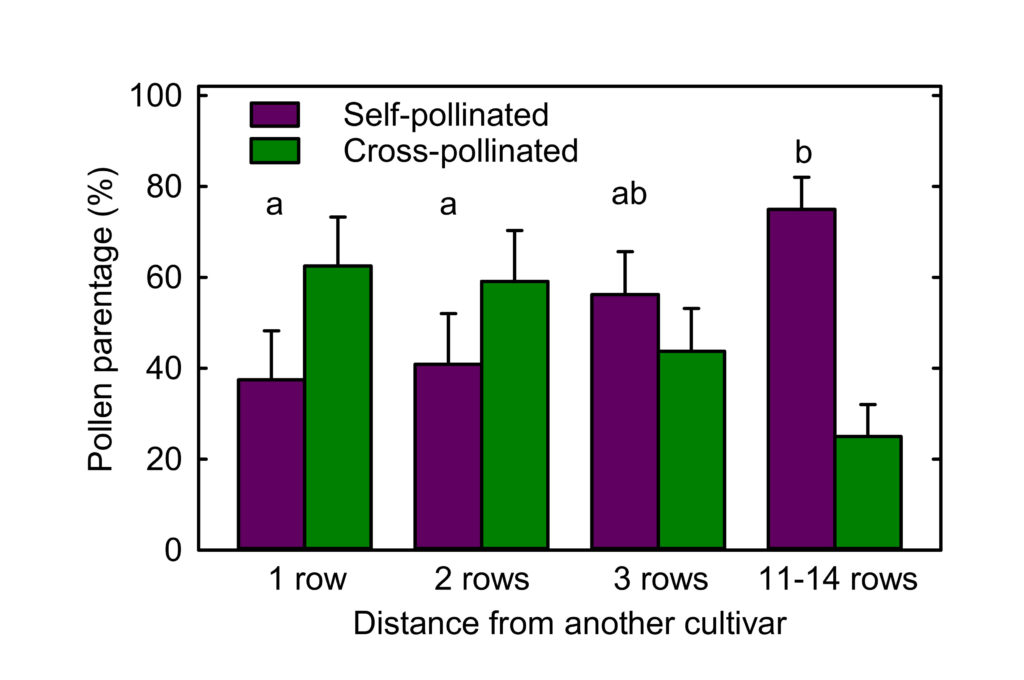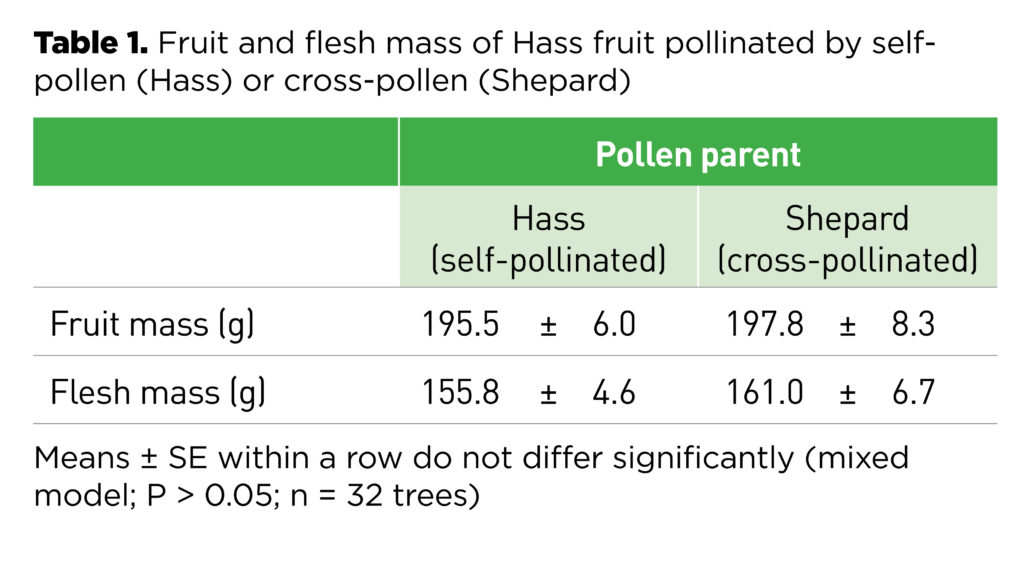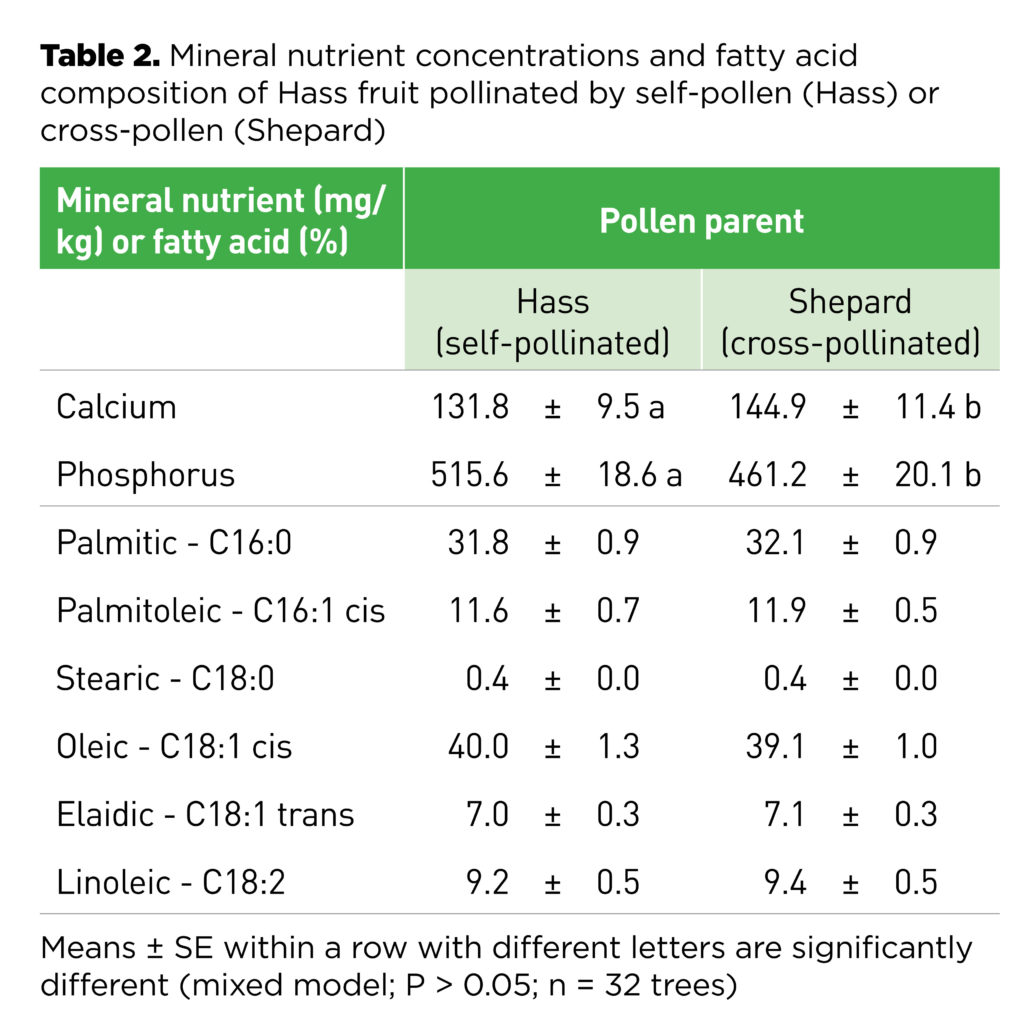The proportion of self-pollinated Hass fruit increases at greater distance from another cultivar
By Wiebke Kämper (Griffith University), Steven Ogbourne (University of the Sunshine Coast), David Hawkes (Australian Genome Research Facility), Stephen Trueman (Griffith University)
Key messages
- Interplanting of Type A cultivars (eg Hass) and Type B cultivars (eg Shepard) increases the chance that avocado flowers are pollinated successfully.
- We used DNA markers to determine whether Hass fruit in two orchards had been self-pollinated by Hass or cross-pollinated by another cultivar, mainly Shepard.
- On average, 37% of fruit in the Hass row next to another cultivar were self-pollinated. This increased to 75% of Hass fruit being self-pollinated at 11–14 rows from another cultivar.
- Fruit mass, flesh mass, and fatty acid composition did not differ significantly between the Hass fruit that were self-pollinated by Hass and the Hass fruit that were cross-pollinated by Shepard.
- The flesh of cross-pollinated fruit had 10% higher calcium levels than self-pollinated fruit.
Avocado flowers are female when they first open and male when they open a second time. In theory, flowers of Type A cultivars such as Hass open as female in the morning, close in the late morning, and re-open as male on the afternoon of the next day. Flowers of Type B cultivars such as Shepard open as female in the afternoon, close in the late afternoon, and re-open as male on the following morning.
Orchards are established with a mixture of Type A and Type B cultivars to maximise the chance that pollen from male-stage flowers is available for pollination of female-stage flowers. However, the timing of the female and male stages may change depending on climatic conditions such as cool temperatures during flowering. There can often be significant overlap between female and male stages within the same cultivar.
Avocado orchards are typically established with each cultivar planted in a wide block, rather than different cultivars being interplanted within the same row or in alternating rows. Wide blocks simplify farm management and may reduce the costs of pest control, disease control and fruit harvesting.
However, planting each cultivar in a wide block might reduce the chance that female-stage flowers are pollinated successfully. Avocado fruit can be produced from self-pollination (by pollen from the same cultivar) or cross-pollination (by pollen from a different cultivar). Therefore, planting each cultivar in a wide block might also increase the chance that most fruit result from self-pollination.
In other crops, such as macadamia, self-pollinated fruit are often smaller and of lower quality than cross-pollinated fruit.
We know comparatively little about the effect of self-pollination on avocado fruit. Here, we assessed the contributions of self-pollination and cross-pollination to avocado fruit production in two Queensland orchards. We also determined whether fruit mass, flesh mass, mineral nutrient concentrations and fatty acid composition differed between self-pollinated and cross-pollinated fruit.
Methods
We harvested Hass fruit from 32 trees in two orchards near Childers, Queensland. The first orchard contained blocks of Hass and Shepard that were 26 rows wide, with row spacing of 10-11 m. The trees were 13-years-old. The second orchard contained blocks of Hass, Shepard, Lamb Hass and Wurtz that were 6-22 rows wide, with row spacing of 10m. Trees were 18-21-years-old. The 32 harvested Hass trees were located along eight transects, with each transect consisting of four individual trees at: (a) 1 row, (b) 2 rows, (c) 3 rows, and (d) 11–14 rows from another cultivar. The last sampling point represented the middle of a Hass block.
Six fruit per tree were stored at 4°C before being ripened at room temperature for 10-12 days. We measured total fruit mass and flesh mass of each fruit. We analysed mineral nutrient concentrations in the flesh using inductively coupled plasma – atomic emission spectroscopy. We analysed fatty acid composition by gas chromatography – mass spectrometry. We determined the pollen parent of each fruit by extracting DNA from the seed and performing MassARRAY genotyping using methods that we developed for avocado.
Results
A total of 52% of Hass fruit arose from self-pollination and 48% of Hass fruit arose from cross-pollination. Almost all (95%) of the cross-pollinated fruit were pollinated by Shepard. The percentage of self-pollinated fruit increased with increasing distance from another cultivar (Figure 1).

Approximately 37% of Hass fruit were self-pollinated and 63% were cross-pollinated in the row next to another cultivar. In contrast, 75% of fruit were self-pollinated and 25% were cross-pollinated in the middle of the Hass blocks, i.e. at 11–14 rows from another cultivar.
Hass fruit that were self-pollinated by Hass did not differ significantly in total fruit mass or flesh mass from Hass fruit that were pollinated by Shepard (Table 1).

The flesh of cross-pollinated fruit had 10% higher calcium and 11% lower phosphorus concentration than self-pollinated fruit (Table 2). Other mineral nutrient concentrations did not differ significantly (data not presented). Self-pollinated and cross-pollinated fruit did not differ significantly in the relative contributions of palmitic, palmitoleic, stearic, oleic, elaidic or linoleic acid to their total fatty acid composition (Table 2).

Discussion
We found almost a 50/50 mixture of self-pollinated and cross-pollinated Hass fruit in two Queensland orchards. However, the percentage of self-pollinated fruit increased from 37% to 75% as we moved from the edge to the middle of the wide Hass blocks. Bees and flies are the main pollinators in avocado orchards.
Our results indicate that pollen vectors were only partly effective in transporting Shepard pollen into the middle of Hass blocks that were 22-26 rows wide. This might affect tree yield, because we expect that pollination and fruit set would be greatest when female-stage flowers of the Type A cultivar Hass have the greatest possible access to pollen from the male-stage flowers of Type B cultivars such as Shepard. Further research is warranted to determine whether yields are lower in the middle than at the edge of wide Hass blocks.
Self-pollinated fruit are often smaller and of lower quality than cross-pollinated fruit in other crops. This is an example of xenia, which is the term used for the effect of different pollen donors on the size or quality of the fruit. However, self-pollinated and cross-pollinated Hass fruit did not differ significantly in fruit mass, flesh mass, and the concentrations of most mineral nutrients. Interestingly, though, Hass fruit that were cross-pollinated by Shepard had higher calcium concentrations than self-pollinated Hass fruit, which suggests they might be less prone to rots and other fruit disorders, and they might have longer shelf life.
Self-pollinated and cross-pollinated Hass fruit did not differ significantly in fatty acid composition. Both types of fruit had the same, distinctive fatty acid profile that makes avocado a valuable component of a healthy, nutritious diet.
Acknowledgement
The Increasing yield and quality in tropical horticulture with better pollination, fruit retention and nutrient distribution project (PH16001) is funded by the Hort Frontiers Pollination Fund, part of the Hort Frontiers strategic partnership initiative developed by Hort Innovation, with co-investment from Griffith University, University of the Sunshine Coast, Plant & Food Research Ltd and contributions from the Australian Government. This research was also funded by the Ruhr University Research School PLUS, which is funded by Germany’s Excellence Initiative [DFG GSC 98/3].
We thank Simpson Farms and Costa Avocado for assistance and access to their orchards. We thank Chris Searle, Helen Wallace, Tarran Richards, Peter Brooks and Tsvakai Gama for advice and assistance.

This article was produced for the Autumn 2021 edition of Talking Avocados.
Date Published: 08/09/2021